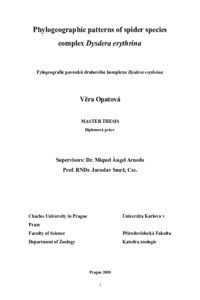Phylogeographic patterns of the spider species complex Dysdera erythrina
Fylogeografie pavouků druhového komplexu Dysdera erythrina
rigorózní práce (UZNÁNO)

Zobrazit/
Trvalý odkaz
http://hdl.handle.net/20.500.11956/86620Identifikátory
SIS: 191653
Kolekce
- Kvalifikační práce [20073]
Autor
Fakulta / součást
Přírodovědecká fakulta
Obor
Zoologie
Katedra / ústav / klinika
Katedra zoologie
Datum obhajoby
26. 6. 2017
Nakladatel
Univerzita Karlova, Přírodovědecká fakultaJazyk
Angličtina
Známka
Uznáno
Schopnost vymezit hranice druhů je v taxonomických studiích nezbytná. Nicméně různé metody delimitace druhů mohou poskytnout nejednoznačné nebo protichůdné výsledky, takže integrace více přístupů je pro správné rozpoznávání druhů často nezbytná. To platí zejména pro taxony vzniklé v nedávných radiacích, které nemusely mít dostatek času na získaní morfologických apomorfií, v jejichž případě by přístup zaměřený striktně na morfologické znaky podcenil skutečnou druhovou rozmanitost. V tomto ohledu se molekulární metody staly užitečným nástrojem pro vymezení druhů. Šestiočka Dysdera erythrina je považována za druhový komplex se širokým geografickým rozšířením (Iberský poloostrov - Gruzie). V minulosti byly od D. erythrina odděleny tři druhy, ale jejich současná taxonomická pozice je nejasná. V této studii je pro delimitaci druhů použit integrativní přístup kombinující molekulární (jeden jaderný, čtyři mitochondriální geny) a morfologická data. Molekulární data jsou dále použita k rekonstrukci fylogenetických vztahů mezi jednotlivými evolučními liniemi a k datovaní jejich vzniku. Ve výsledných fylogenetických analýzách tvořily D. fervida a D. lantosquensis nezávislé monofyletické klády, které byly podpořené také morfologií, ale jedinci D. erythrina a D. provincialis tvořili klád jeden. Pomoci dvou metod...
The ability to delimit species boundaries is essential in taxonomic studies. However, different methods of delimitation may give ambiguous or contradictory results, thus integration of multiple approaches is often necessary for correct species recognition. This is especially true for taxa originated in recent radiations that may not have had sufficient time to accumulate morphological apomorphies, in which case a strictly morphology based approach would underestimate the real species diversity. In this regard, molecular methods became a useful tool for species delineation. The woodlouse hunter spider Dysdera erythrina is considered a sibling species complex with wide geographic distribution (Iberian Peninsula to Georgia). Three species have been separated from D. erythrina in the past, however their current taxonomic position remains unclear. In this study an integrative approach combining molecular (one nuclear, four mitochondrial genes) and morphological data is used for species delimitation. Molecular data are further used in order to reconstruct the phylogenetic relationships among the lineages and estimation of the time frame of their diversification. In the phylogenetic analyses Dysdera fervida and D. lantosquensis formed independent monophyletic clades supported also by morphology, but D....
